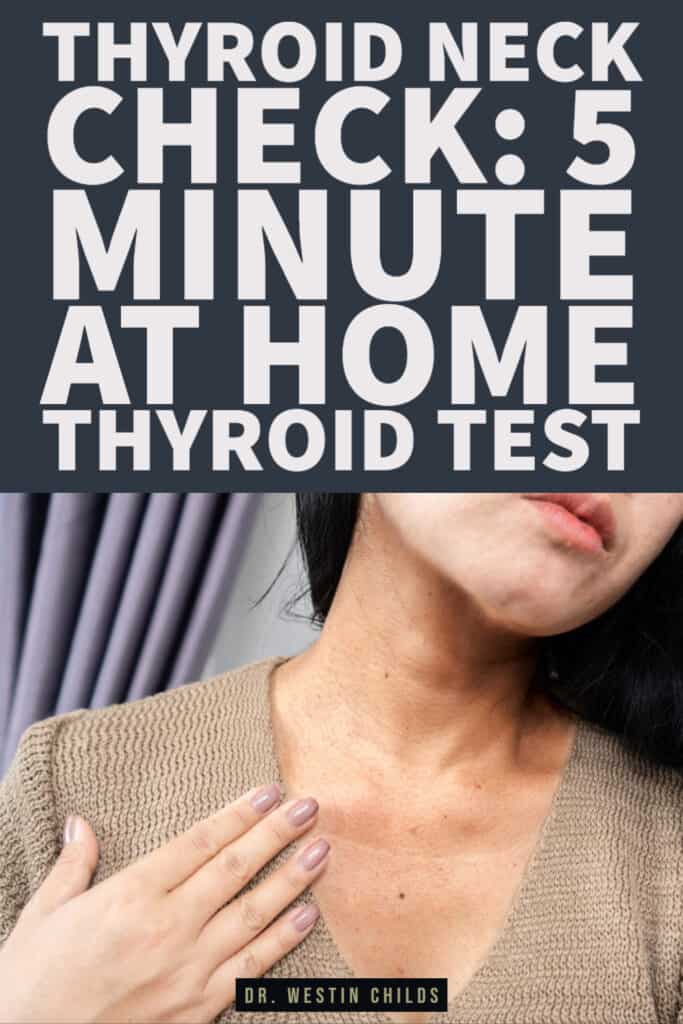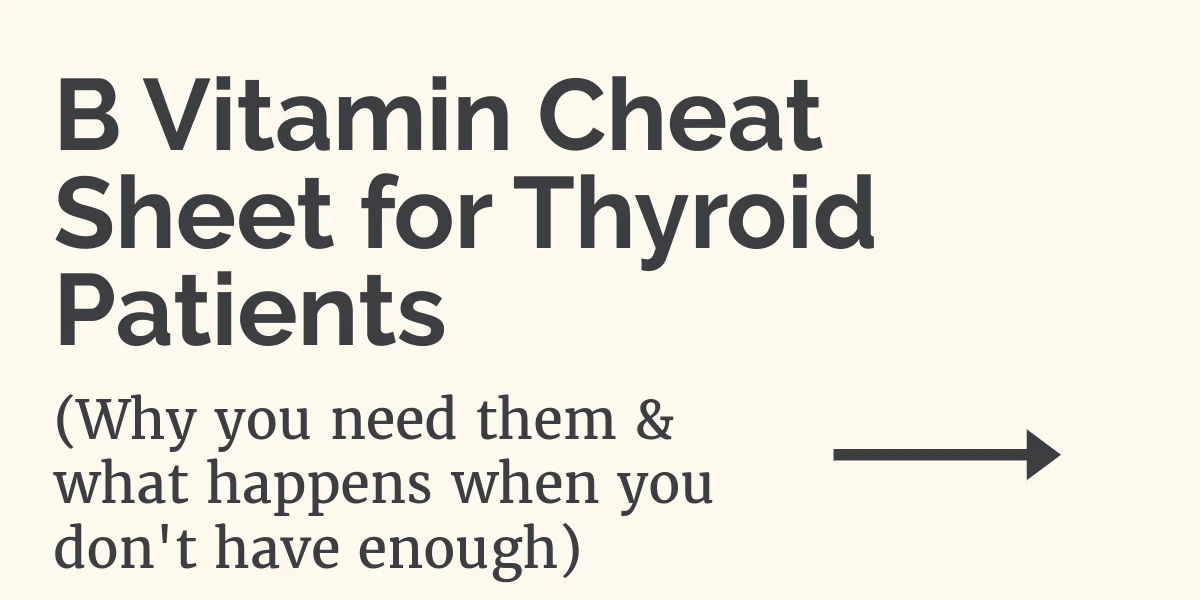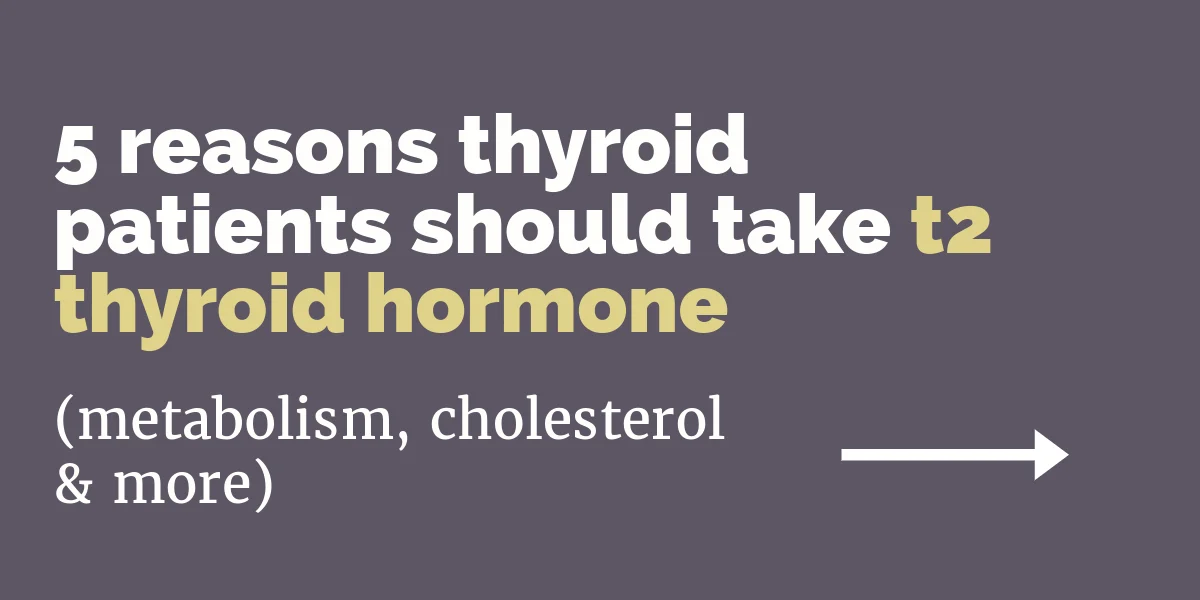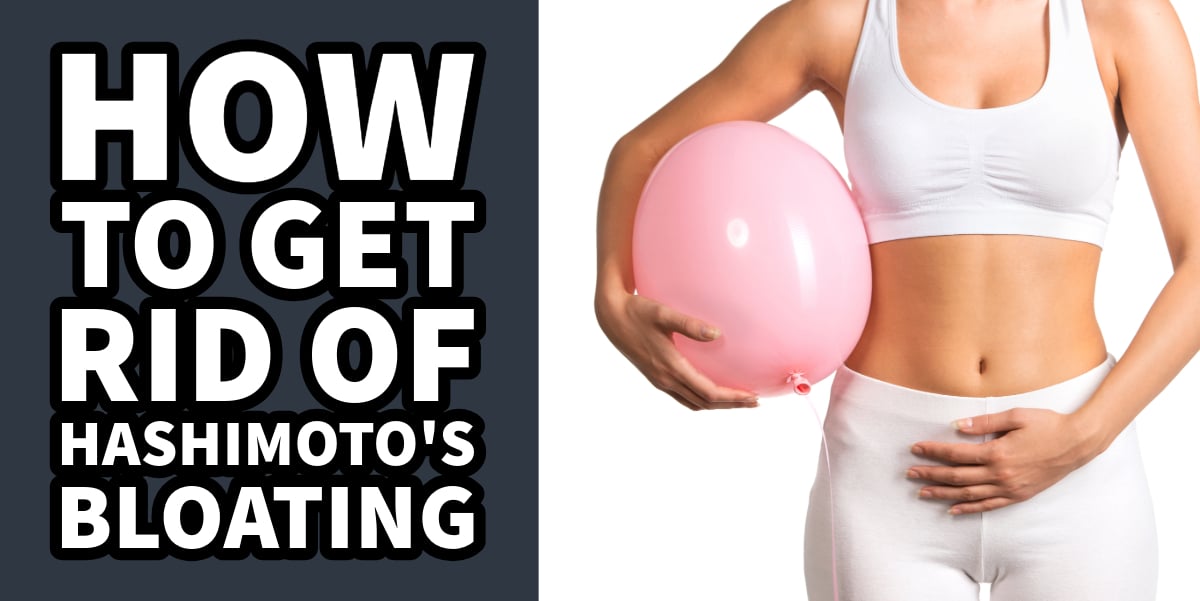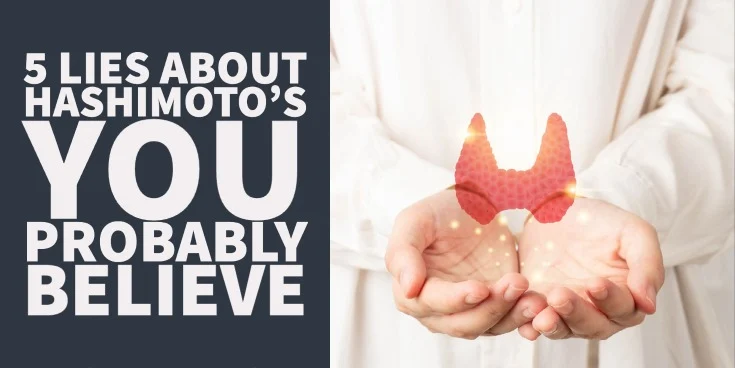All over the world thyroid patients are standing up and taking control of their health and their thyroid management.
This is such a great thing because it helps thyroid patients get the treatment and symptom management that they deserve.
Part of this move to patient advocacy should include understanding how to do a basic self neck check of your thyroid gland.
You can think of this neck check as similar to a female self breast exam (1) which can help you identify problems in your thyroid gland early.
The earlier you identify these problems the better your outcome will be!
Today you will learn:
- How to check the physical shape and size of your thyroid gland in under 5 minutes.
- What type of information this test gives you regarding the shape and size of your thyroid gland.
- What type of information it doesn’t give you (and how to get that information).
- What to do if you feel something abnormal in your thyroid gland (and how to follow up with your doctor).
- And how to properly assess thyroid function.
Let’s jump in…
DOWNLOAD FREE RESOURCES
Foods to Avoid if you Have Thyroid Problems:
I’ve found that these 10 foods cause the most problems for thyroid patients. Learn which foods you should avoid if you have thyroid disease of any type.
The Complete List of Thyroid Lab tests:
The list includes optimal ranges, normal ranges, and the complete list of tests you need to diagnose and manage thyroid disease correctly!
How to Perform a Thyroid Neck Check:
Step #1. Get a Small Glass of Water.
The first thing you need to get is a glass of water.
This glass of water is used for you to take small sips and is necessary to observe your thyroid gland.
Get enough water for you to take a few sips in case you need to do the check a couple of times!
Step #2. Stand in Front of a Mirror.
Once you have your glass of water in hand, find a big mirror.
You will need to find a mirror big enough to see your head and neck so something like a bathroom mirror works best.
You can get by with a handheld mirror but it’s a little more difficult to hold the mirror, swallow, and watch your thyroid gland all at the same time.
Step #3. Find the Base of Your Neck & Thyroid Gland.
Before proceeding to the drinking part it’s a good idea to get a basic sense of what you are looking at!
From an anatomical standpoint, your thyroid sits at the base of your neck (2) underneath what is called your larynx.
Your larynx is a hard piece of cartilage that houses your voicebox.
Your thyroid gland wraps around your windpipe (trachea) and sits just below the larynx.
The picture below will help you visualize what I am talking about.
When you proceed through the next steps you will want to pay close attention to that area of your neck.
The reason this self-test works is that it takes advantage of the fact that your thyroid gland is so superficial (close to the skin).
When you swallow, your trachea moves up and down and when it does, it carries with it your thyroid.
Remember when I said that the thyroid gland wraps around the trachea?
As the thyroid moves up and down you will see it glide underneath your skin and this is where you want to pay close attention.
As it glides underneath your skin you will be able to easily spot bumps or inconsistencies in the texture of the thyroid gland by looking at your skin.
If this is sounding somewhat confusing then just focus on the bottom one-third of the center of your neck, right above when your collar bones connect to your sternum, as you swallow.
This isn’t precise but it’s a down-and-dirty way to do it.
Step #4. Take a Small Sip of Water, Extend your Neck Back, and Swallow.
Once you feel comfortable with what you are looking at (if you need to, re-read what I wrote in step #3 a few times) you can proceed to the next step.
The most important part of this step is making sure that you are positioned in such a way that you can see the base of your neck when you swallow your water.
This can sometimes be tricky because it requires you to have your neck extended (like you are looking up at the ceiling) while you swallow a sip of water while you monitor the base of your neck with your eyes.
Neck extension here is very important because it pulls your skin tight.
And the tightening of the skin is necessary to see the bumps and inconsistencies that I mentioned previously as your thyroid glides underneath the skin.
As a precaution, if you tend to get dizzy with moving your head around, make sure you grab something tight before you extend your neck.
Step #5. Monitor the Base of Your Neck For Bumps or Inconsistencies.
The next step is to pay close attention to the base of your neck as you swallow.
What are you looking for?
Really anything that stands out but here are a few ways to describe what you might see:
- Bumps or lumps in the center, left, or right of your neck that move up and down when you swallow.
- A big enlargement of the base of your neck that moves up and down when you swallow.
- An enlargement on one side of your neck (or the other) that moves up and down when you swallow.
- Anything that looks off-center or abnormal
Pro tip! Don’t confuse your Adam’s apple with your thyroid gland!
Your Adam’s apple is a piece of cartilage that is in the front of your larynx (where your voice box is).
When you lean your head back this may look like a protrusion in the center of your neck but that’s completely normal.
The Adam’s apple is more pronounced in men than in women but you can still see it in women, especially when you extend your neck.
The relative size of your Adam’s apple depends on your anatomy, genetics, and other factors.
Your focus should be underneath your larynx and Adam’s apple, that’s where you want to look for inconsistencies.
Step #6. Repeat Again a Few Times as Necessary.
Don’t be afraid to repeat this step a few times until you get the hang of it.
When I was first learning how to do this as a resident, it took me several times before I knew exactly what I was looking at and where to look.
Just make sure to take some small sips and swallow frequently.
It’s the action of swallowing that causes your trachea to move which highlights the thyroid gland.
(Optional) Step #7. Gently Feel The Base of Your Neck to See if you can Feel Any Bumps or Inconsistencies.
Finally, you can also do a physical palpation test of your thyroid gland after you do the swallow test.
This exam is somewhat similar to a self breast exam.
You simply feel (softly) around the base of your neck where your thyroid gland sits to see if you notice any bumps or lumps on or around your thyroid gland.
This step is certainly not required and I would caution when palpating or feeling your thyroid gland as you may cause more harm than good.

But if you notice something off then you can always double-check with a simple physical exam of your neck.
If you notice anything that looks funny, off, or inconsistent then you will want to follow up with your doctor!
I will explain more about that below.
What Does A Thyroid Neck Check Tell You?
Even though a thyroid neck check is very easy to perform and simple to do at home, it’s limited in what type of information it gives you about the thyroid.
The swallow neck check only provides you with information about the size or texture of your thyroid gland.
This means it’s helpful for checking for things like:
- Thyroid nodules
- Thyroid cancer
- Thyroid cysts
- Goiter
- Infections (3) of the thyroid gland (rare)
- Enlarged lymph nodes in the neck (uncommon but can be confused for thyroid nodules if you are feeling in the wrong area)
The list above highlights various problems that all result in changes to the physical size or shape of your thyroid gland.
Unfortunately, many of the problems that people are most concerned about are not addressed with this self-test.
What it Doesn’t Check For:
A thyroid neck check will not give you information about the function of your thyroid gland.
In other words, it won’t tell you whether or not your thyroid is producing thyroid hormone.
Thyroid function refers to your thyroid’s ability to do its job:
Produce thyroid hormone that then influences the rest of your body.
Thyroid hormone is responsible for giving you energy, regulating your metabolism, helping your hair to grow, managing your heart rate, helping your bowels move, and much more.
When your thyroid can’t produce enough thyroid hormone you are said to be in a state of low thyroid or hypothyroidism.
When your thyroid produces too much thyroid hormone you are said to be in a state of high thyroid or hyperthyroidism.
Unfortunately, the thyroid neck check does not give you much information about either of these conditions.
Most of the time, conditions such as thyroid cancer, thyroid nodules, and thyroid cysts have no impact on the function of your thyroid gland (meaning they do not impact your thyroid hormones).
Thyroid hormone function is typically independent (though, not always) of physical changes to your thyroid gland size, texture, and shape.
If you want to check how well your thyroid is producing thyroid hormone then you will need to get blood tests including:
- Thyroid-stimulating hormone
- Free T3
- Free T4
- Reverse T3
- Total T3
- Thyroid peroxidase antibody
- Thyroglobulin antibody
There are still some methods to get these tests checked at home but it will require you to give up some blood either through a fingerprick or some other method.
Right now, we do not have the technology to assess thyroid function by simply looking at the thyroid gland or physically feeling it.
Follow Up Tests & Recommendations
What are you supposed to do if you find that your thyroid neck check is off?
Because a self neck check is not the most accurate way to assess the size or shape of your thyroid gland, you always want to confirm your results with something that is more accurate!
Self-neck checks are great because they can help you identify thyroid problems early but they are not accurate because a lump that you feel on your thyroid gland could be something as benign as a thyroid nodule or something more serious like thyroid cancer.
All you know when you do your test is that you feel some sort of lump or bump.
But you won’t know what that lump or bump actually is until you get further tests.
Additional tests you can get if you find that your self neck check is abnormal include:
- Thyroid ultrasound – This is a noninvasive way (4) to look at the size and shape of your thyroid gland. It’s cheap, doesn’t have any side effects, and can be done fairly quickly. Thyroid ultrasounds are also not the most accurate of all the tests available but they are a great first step. When you get a thyroid ultrasound you may be told that your lump or bump has certain features which may indicate it is more likely or less likely to be something serious like thyroid cancer.
- A CT scan of your head and neck – CT, or computed tomography, scans are not typically used for assessing your thyroid gland but they can be used in certain situations (5). Most of the time, thyroid gland findings on a CT scan are found incidentally usually when someone gets a CT scan of their chest looking for something abnormal there. CT scans are generally not used for thyroid gland abnormalities because they expose the person getting them to a fair amount of radiation (something that the thyroid gland is sensitive to). For this reason, most doctors start with ultrasounds instead of CT scans.
- A fine need aspiration or biopsy – A biopsy of a portion of your thyroid gland can be performed if a CT scan or thyroid ultrasound shows something suspicious. A biopsy is considered the most accurate test (6) for assessing thyroid bumps and lumps because a pathologist can actually look at the cells of your thyroid gland to see what is happening. Even though it’s the most accurate, it shouldn’t be done unless absolutely necessary because you don’t want to go sticking needles in your neck unless you need to!
- Thyroid hormone blood tests – Lastly, as mentioned above, your doctor may also order thyroid function lab tests in order to assess your thyroid.
Final Thoughts
It can be frustrating when you only see your thyroid doctor once or twice a year and the rest of the time you are left feeling poorly.
Learning how to do some simple procedures and self-tests can help you take control of your health and your thyroid!
Simple things like a thyroid neck check, keeping track of your symptoms with a thyroid symptom journal, and keeping records of your thyroid lab tests (blood work), can go a long way to helping you get back to 100%.
And by the way, there are things that you can do on your own (that don’t require a prescription from your doctor) that can help improve the size and function of your thyroid.
If you want to see a list of what works best, check out this resource.
Now I want to hear from you:
Have you tried to evaluate your own thyroid gland before?
Did you find it difficult or easy to do?
Did you notice any inconsistencies, lumps, or bumps in your thyroid gland?
Do you believe your problem is more about thyroid function and not the size or shape of your thyroid gland?
Leave your questions or comments below!
Scientific References
#1. ncbi.nlm.nih.gov/books/NBK565846/
#2. ncbi.nlm.nih.gov/books/NBK470452/
#3. ncbi.nlm.nih.gov/books/NBK555975/
#4. ncbi.nlm.nih.gov/pmc/articles/PMC3683194/
#5. ncbi.nlm.nih.gov/pmc/articles/PMC4956631/
#6. ncbi.nlm.nih.gov/books/NBK285544/
